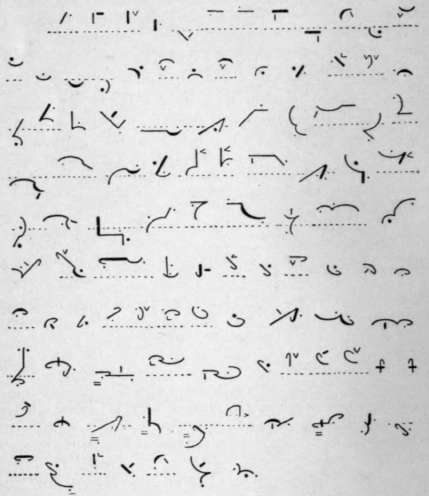Halving Principle.
Description
This section is from the "A Shorter Course in Munson Phonography" book, by James E. Munson. Also available from Amazon: A Shorter Course in Munson Phonography
Halving Principle.
251. "T" or "D" Added by Halving. - Either t or d may be added to any stem, straight or curved, simple or hooked, by making it half its ordinary length.
252. The Names of the Half-length Stems are Chet or Ched, Jet or Jed, Tet or Ted, Det or Ded, Pet or Ped, Bet or Bed, Ket or Ked, Get or Ged, Ret or Red, Elt or Eld, Yet or Yed, Thet, Thed, or Itht, Dhet or Dhed, Fet or Fed, Vet or Ved, Net or Ned, Ingt, Sheet, Isht, Zhed, Est, Zed, Ert or Erd, Wet or Wed, Met or Med, Het or Hed, and Leet or Leed ; Chent, Tend, Bent, Rent, Fend, Vent, Nent, Essent, Ernd, Mend, Lent, Pĕshunt, Fĕshund, Enshunt, Chetterd, Betterd or Bĕtherd, Plet, Gled, Tred, Bred, Flet, Fred, Nerd, Lerd, Plent, Trend, Frend, etc.
Examples:

253. Order of Reading Vowel-Sign. - A vowel-sign placed after a half-length stem is read before the added t or d (250). Examples:

254. Hooks Made Smaller. - All of the hooks, both large and small, when added to half-length stems, should be made considerably smaller than the corresponding hooks on full-length stems. But the general proportion between the two sizes should still be retained (183 and Remark, also 266).
255. Positions of Half-Length Stems. — The positions of half-length horizontal stems are the same as the positions of full-length horizontals (43 to 45).
256. The positions of half-length upright or slanting stems are shown in the cut below, and are as follows:
First Position. - Half the length of a Tee above the line.
Second Position. - On the line.
Third Position. - Entirely below the line.
![]()
Remark. The caution at 177, in regard to writing horizontals in the Fourth Position, applies also to all words written with half-lengths of any direction. The reason for this restriction is that the Third and Fourth Positions of all such stems, being both entirely below the line, are liable to be mistaken one for the other. And yet it is not to be understood absolutely that the practised reporter may never use the Fourth Position with such words, for sometimes when hard pushed by a speaker it comes handy to do so, at the risk of a little illegibility ; as, for instance, in writing to go, to make, to put, to treat, to let, too bright, etc. But the beginner should always use T3 for to or too in such cases.
257. Ing-dot after Half-Lengths. — After half-length Tee, Dee, Pee, Bee, El, Yay, Em, and Hay, the final syllable ing is best written with the Ing-dot (148).
258. Lee after Wet, Met, Het, and Leet. - After half-length Way, Em, Hay, and Lee the stem Lee is generally used whether a vowel-sound follows or not; as in writing wattle, motley, metal, hotly, hotel, lately, little, etc.
Remark. The caution at 177, in regard to writing horizontals in the Fourth Position, applies also to all words written with half-lengths of any direction. The reason for this restriction is that the Third and Fourth Positions of all such stems, being both entirely below the line, are liable to be mistaken one for the other. And yet it is not to be understood absolutely that the practised reporter may never use the Fourth Position with such words, for sometimes when hard pushed by a speaker it comes handy to do so, at the risk of a little illegibility ; as, for instance, in writing to go, to make, to put, to treat, to let, too bright, etc. But the beginner should always use T3 for to or too in such cases.
257. Ing-dot after Half-Lengths. - After half-length Tee, Dee, Pee, Bee, El, Yay, Em, and Hay, the final syllable ing is best written with the Ing-dot (148).
258. Lee after Wet, Met, Het, and Leet. - After half-length Way, Em, Hay, and Lee the stem Lee is generally used whether a vowel-sound follows or not; as in writing wattle, motley, metal, hotly, hotel, lately, little, etc.
Reading Exercise.

Remark. Whenever it is necessary to join a straight half-length after a curve, which it would naturally follow without an angle (87, 88), for the purpose of showing the exact point of junction, the tip of the curved stem should be bent in a little, so as to allow the half-length to start with a slight jog or angle. The outlines of the following words furnish examples of such joinings: mapped, mobbed, escheat, throbbed, etc.
Writing Exercise.
250. Jet, tight or tide or tied, date, beat or bead, caught, ached, get, rate, thought, fate, void, not, note, shut, art, met, hat, light, added, await, omit, checked, touched, picked, kept, urged, robbed, ranked, failed, moped, armed, lodged, ticket, adopt, pulled, pilot, acted, gilt or guilt or gild, repute, elect, voted, noted, estate, assumed, merit, alleged, battle, fatal, esteem, motive, hotel, little, punished, return, prompt, attract, tent or tend, dined, pound, bond, find, want, mind, hunt, lent or lend, paved, patient, battered, event, arrived, occasioned, patent, turned, payment, behind, judgment, agreement, country, authentic, prate, dread, freight, fleet, cord, rolled, word, offered, injured, Albert, measured, mortal, candidate, rendered, treatment, shorthand, plant or planned, frowned, friendly; putting, trading, meeting, heading.
Continue to:
Also see:
- Unvocalized Phonography.
- Phonography. Lesson XX. Words Commencing With "In," "En," "Un," "Il," "Im," "Ir."
- Phonography. Lesson XV. Circles And Loops.
- Phonography. Lesson X. The Shun-Hook.
- Phonography. Lesson XVIII. Curls For The Nasals En And Ing. Final Curls
- Phonography. Lesson V. Downward And Upward Stems. Er, Ree, Ish, Shee, El, And Lee.


